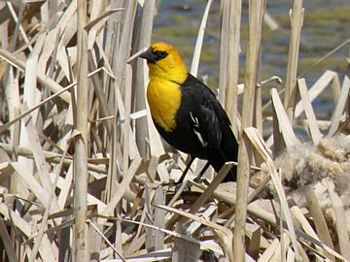|
|
|
The bright patch on the wings of dabbling ducks like the Mallard is called a speculum. |
|
About 60 percent of the world’s bird species belong to a group called the passerines or perching birds. Most passerines are also songbirds. |
| |
|
|
|
|
|
The stilt is the bird with the longest legs in proportion to its body. This allows it to feed in deeper waters than other waders. |
|
Hummingbirds don’t fly by flapping their wings like other birds. Instead they twist their wings back and forth in a figure-eight pattern. This allows them to hover in one position. |
| |
|
|
|
|
|
There are about 9,700 species of birds in the world. 630 species have been seen in Canada and almost 900 in the United States. |
|
The Bald Eagle is a powerful flyer and has a huge wing span – longer than the height of a man. |
| |
|
|
|
|
|
Songbirds have an organ called a syrinx which allows them to produce complicated songs. The songs are usually sung by males to attract a mate or claim territory. |
|
Pigeons and doves are able to feed their young in a unique way. They produce a milk-like protein rich substance called crop milk. |
| |
|
|
|
|
|
Swans are heavy birds and need an extra push to take off, so they must sprint across the water using it as a runway until they are airborne. |
|
The Osprey hunts fish by plunging into the water and grasping a fish with its talons. Its feet are covered with sharp scales for extra grip. |
| |
|
|
|
|
|
Vultures have bald heads and necks. This allows them to push deep into a carcass without getting their plumage dirty. |
|
Some woodpeckers can hammer away at wood at an amazing rate of 25 mph/40 km/h – 20 times a second! |
| |
|
|
|
|
|
The bills of owls point down to allow for unobstructed vision. |
|
The eggs of a hummingbird are about the size of a pea. The nest is thimble sized.
|
| |
|
|
|
|
|
Swans, ducks and geese smear themselves with a waterproof oil from a gland on their rear. This oil makes water slide off their feathers.
|
|
Songbirds have long, slender, flexible toes. There are three forward-facing toes and one backward-facing toe which allow the bird to grip various sized twigs. |
| |
|
|
|
|
|
There are about 60 species in the family of falcons (Falconidae) including this Merlin. They have pointed wings and a sort of tooth on the upper bill.
|
|
Shock-absorbing muscles and a very thick skull protect the brains of woodpeckers. Furthermore, to stop the bill from crumbling it locks shut. |
| |
|
|
|
|
|
Although it can also fly, the Common Roadrunner is best known for the fact that it can sprint after prey at a rate of 15 mph/24km/h. |
|
Some birds such as plovers will fake an injury such as having broken to lure predators away from their nest.
|
| |
|
|
|
|
|
The Red-breasted Merganser is one of the fastest flyers. It has been recorded flying at 100 mph/160 km/h in level flight. |
|
Members of the bird family Accipitridae include over 200 species of eagles, hawks, kites, harriers and Old World vultures. |
| |
|
|
|
|
|
In some cultures the Common Raven is considered to be a trickster because of its clever and cheeky ways. Adults couples form bonds which last a lifetime.
|
|
The Caspian Tern is the world’s largest tern. They hunt fish by hovering above the water and plummeting down for their prey. |
| |
|
|


























